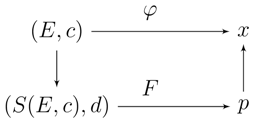From Bargaining Solutions to Claims Rules: A Proportional Approach
Abstract
:1. Introduction

2. Preliminaries
2.1. Conflicting Claims Problems and Rules
2.2. Bargaining Problems and Solutions
3. Bargaining-In-Proportions: Correspondence between Bargaining Solutions and Claims Rules
- and
- and
- and
- and
- and for and
- and
- and
4. Final remarks
Acknowledgments
Appendix
A1: Proof of Proposition 1 part (1)
A2: Proof of Proposition 1 part (2)
A3: Proof of Proposition 1 part (3)
A4: Proof of Proposition 1 part (4)
A5: Proof of Proposition 1 part (5)
A6: Proof of Proposition 2
Author Contributions
Conflicts of Interest
References
- Chun, Y. The proportional solution for rights problem. Math. Soc. Sci. 1988, 15, 231–246. [Google Scholar] [CrossRef]
- Thomson, W. Axiomatic and game-theoretic analysis of bankruptcy and taxation problems: A survey. Math. Soc. Sci. 2003, 45, 249–297. [Google Scholar] [CrossRef]
- Young, P. Equity in Theory and Practice; Princeton University Press: Princeton, NJ, USA, 1994. [Google Scholar]
- O’Neill, B. A problem of rights arbitration from the Talmud. Math. Soc. Sci. 1982, 2, 345–371. [Google Scholar] [CrossRef]
- Malkevitch, J. Resolving Bankruptcy Claims. Feature Column from the AMS 2012. [Google Scholar]
- Nash, J. The bargaining problem. Econometrica 1950, 18, 155–162. [Google Scholar] [CrossRef]
- Dagan, N.; Volij, O. The bankruptcy problem: A cooperative bargaining approach. Math. Soc. Sci. 1993, 26, 287–297. [Google Scholar] [CrossRef]
- Kalai, E. Proportional Solutions to Bargaining Situations: Interpersonal Utility Comparisons. Econometrica 1977, 45, 1623–1630. [Google Scholar] [CrossRef]
- Thomson, W. Axiomatic and Game-theoretic Analysis of Bankruptcy and Taxation Problems: An Update; Working Paper No. 578; Rochester Center for Economic Research: Rochester, NY, USA, August 2013. [Google Scholar]
- Aumann, R.J.; Maschler, M. Game Theoretic Analysis of a bankruptcy from the Talmud. J. Econ. Theory 1985, 36, 195–213. [Google Scholar] [CrossRef]
- Curiel, J.; Maschler, M.; Tijs, S. Bankruptcy games. Z. Oper. Res. 1987, 31, A143–A159. [Google Scholar] [CrossRef]
- Thomson, W. Cooperative models of bargaining. In Handbook of Game Theory with Economic Applications; Aumann, R., Hart, S., Eds.; Elsevier: Amsterdam, The Netherlands, 1994; Charpter 35; pp. 1237–1284. [Google Scholar]
- Kalai, E.; Smorodinsky, M. Other Solutions to Nash’s Bargaining Problem. Econometrica 1975, 43, 513–518. [Google Scholar] [CrossRef]
- Harsányi, J.; Selten, R. A Generalized Nash Solution for Two-Person Bargaining Games with Incomplete Information. Manag. Sci. 1972, 18, 80–106. [Google Scholar] [CrossRef]
- Roth, A. Axiomatic Models of Bargaining; Springer-Verlag: Berlin, Germany, 1979. [Google Scholar]
- Sudhölter, P.; Zarzuelo, J.M. Extending the Nash solution to choice problems with reference points. Games Econ. Behav. 2013, 80, 219–228. [Google Scholar] [CrossRef]
© 2015 by the authors; licensee MDPI, Basel, Switzerland. This article is an open access article distributed under the terms and conditions of the Creative Commons Attribution license (http://creativecommons.org/licenses/by/4.0/).
Share and Cite
Giménez-Gómez, J.-M.; Osório, A.; Peris, J.E. From Bargaining Solutions to Claims Rules: A Proportional Approach. Games 2015, 6, 32-38. https://doi.org/10.3390/g6010032
Giménez-Gómez J-M, Osório A, Peris JE. From Bargaining Solutions to Claims Rules: A Proportional Approach. Games. 2015; 6(1):32-38. https://doi.org/10.3390/g6010032
Chicago/Turabian StyleGiménez-Gómez, José-Manuel, António Osório, and Josep E. Peris. 2015. "From Bargaining Solutions to Claims Rules: A Proportional Approach" Games 6, no. 1: 32-38. https://doi.org/10.3390/g6010032
APA StyleGiménez-Gómez, J.-M., Osório, A., & Peris, J. E. (2015). From Bargaining Solutions to Claims Rules: A Proportional Approach. Games, 6(1), 32-38. https://doi.org/10.3390/g6010032




